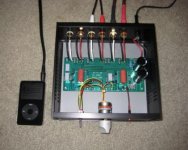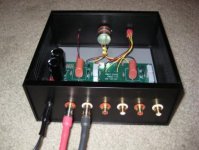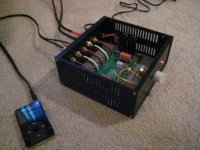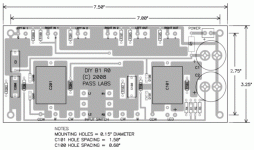I'm going to get stoned for this by the preamp brigade.
The simplest way to determine if your preamp is a wasted gain stage (source of more distortion) in your system is to plug your Cd player directly into your poweramp, put on a known low recorded cd and see if it is loud enough for you. If it is then your preamp is just another gain stage with potential distortions and colorations that you have no use for.
A passive control if impedance matched will be cleaner, if not matched then a passive control with Nelsons B1 buffer is the next best thing.
I believe active preamps are an unecesarcery hang-over from the golden phono era, that are useless source of distortions and coloration in the Cd era, in 99% of cases.
Some have said to me they like the sound of their system with an active preamp instead of a suitably matched passive, that's fair. I believe that they like the coloration/distortion that their active pre is introducing into their system, because it's fixing another problem that needs this coloration/distortion to make it sound right/tonally balanced, this is a band-aid fix, and not fixing the source of that problem.
OK now give it to me!
Cheers George
The simplest way to determine if your preamp is a wasted gain stage (source of more distortion) in your system is to plug your Cd player directly into your poweramp, put on a known low recorded cd and see if it is loud enough for you. If it is then your preamp is just another gain stage with potential distortions and colorations that you have no use for.
A passive control if impedance matched will be cleaner, if not matched then a passive control with Nelsons B1 buffer is the next best thing.
I believe active preamps are an unecesarcery hang-over from the golden phono era, that are useless source of distortions and coloration in the Cd era, in 99% of cases.
Some have said to me they like the sound of their system with an active preamp instead of a suitably matched passive, that's fair. I believe that they like the coloration/distortion that their active pre is introducing into their system, because it's fixing another problem that needs this coloration/distortion to make it sound right/tonally balanced, this is a band-aid fix, and not fixing the source of that problem.
OK now give it to me!
Cheers George
As I understand the principle of the B1, the answer to your question would be: Yes, if you need the 6 dB of gain. Otherwise you'll be applying 6 dB of gain, just to attenuate it, which in reality will be adding the distorsion of 6 dB gain and the distorsion of 6 dB attenuation in order to get the same level of signal.
It seems most people have misunderstood what I was trying to point out.
My post was not about whether the Burson Buffer is better than the B1.
It was to point out that using a buffer between the cd player and preamp/passive volume control may improve the sounnd further due to the high output impedance of a lot of mid-priced cd players.
The Aleph P1.7 seems to take advantage of this also by putting the volume pot on the output of the preamp so the cd player sees a constant hi impedance, while the output impedance varies depending on the volume setting.
So I was merely suggesting for people to try this as they may find an improvement in sound espescially if they have an average cd player.
My post was not about whether the Burson Buffer is better than the B1.
It was to point out that using a buffer between the cd player and preamp/passive volume control may improve the sounnd further due to the high output impedance of a lot of mid-priced cd players.
The Aleph P1.7 seems to take advantage of this also by putting the volume pot on the output of the preamp so the cd player sees a constant hi impedance, while the output impedance varies depending on the volume setting.
So I was merely suggesting for people to try this as they may find an improvement in sound espescially if they have an average cd player.
the usual way to do it is to locate the volume control where you don't need it, i.e. behind the speakers where the power amps belong.thanh1973 said:It seems most people have misunderstood what I was trying to point out........................................So I was merely suggesting for people to try this as they may find an improvement in sound
The most convenient place for the volume control is near where you sit to listen and that is usually where the CD player sits as well.
Locate the volume control beside the source components and add a buffer after the volume control to drive the long cables to the power amps.
CD/DVD players --> B1 Buffer--> volume attenuator --> B1 Buffer --> Power Amp
If you try this you will need to replace the 1k resistor (ie R102, and R202) of the first B1 buffer with a much higher value, maybe 100k. No need to do this on the second B1 as their is a volume pot before it.
I am not sure what the optimum value should be, I suppose it depends on the output impedance of your cd player.
You could also experiment with lowering the value of R104 and R204. However this could cause instability as Nelson has said before.
However it doesn't hurt to try, this is diy after all. What you could do is put in a 1k pot, then starting at the highest value slowly reduce resistance until you find the the swwet spot.
Measure the value of the pot then round this value up to nearest known fixed resistor (for stability margin).
Let say you measured 302 Ohms then you might would round this up to maybe a 316 Ohm fixed resistor (This is just an example).
I think this value will vary depending on the input impedance of your power amp, so it won't be the same for everyone.
I would probably do this on the last B1 buffer at first as there is starting to be too many variables on the first B1 due to the volume pot at the output, which will change depending on the volume you listen to.
Anyway this is just some ideas for people who might like to tweak.
There is no guarantee there will be a significant improvement.
If you try this you will need to replace the 1k resistor (ie R102, and R202) of the first B1 buffer with a much higher value, maybe 100k. No need to do this on the second B1 as their is a volume pot before it.
I am not sure what the optimum value should be, I suppose it depends on the output impedance of your cd player.
You could also experiment with lowering the value of R104 and R204. However this could cause instability as Nelson has said before.
However it doesn't hurt to try, this is diy after all. What you could do is put in a 1k pot, then starting at the highest value slowly reduce resistance until you find the the swwet spot.
Measure the value of the pot then round this value up to nearest known fixed resistor (for stability margin).
Let say you measured 302 Ohms then you might would round this up to maybe a 316 Ohm fixed resistor (This is just an example).
I think this value will vary depending on the input impedance of your power amp, so it won't be the same for everyone.
I would probably do this on the last B1 buffer at first as there is starting to be too many variables on the first B1 due to the volume pot at the output, which will change depending on the volume you listen to.
Anyway this is just some ideas for people who might like to tweak.
There is no guarantee there will be a significant improvement.
do not change R102/202. Just connect the source direct to this input and omit the volume control.
If the Rs of the source <=500r then the first buffer may not be required. If Rs is between 501r and 2000r then the first buffer may sound better than none.
If there is a lot of capacitance after the last buffer then some experimentation with R104/204 may prove useful. Try it, but don't reduce below 200r.
If the Rs of the source <=500r then the first buffer may not be required. If Rs is between 501r and 2000r then the first buffer may sound better than none.
If there is a lot of capacitance after the last buffer then some experimentation with R104/204 may prove useful. Try it, but don't reduce below 200r.
AndrewT
Thanks Andrew
I might try your idea also, but wouldn't you then need something like an F4 because of the high currents.
I don't think the B1 or simple passive volume control could cope with the high currents seen at the output of a poweramp?
the usual way to do it is to locate the volume control where you don't need it, i.e. behind the speakers where the power amps belong.
The most convenient place for the volume control is near where you sit to listen and that is usually where the CD player sits as well.
Locate the volume control beside the source components and add a buffer after the volume control to drive the long cables to the power amps.
Thanks Andrew
I might try your idea also, but wouldn't you then need something like an F4 because of the high currents.
I don't think the B1 or simple passive volume control could cope with the high currents seen at the output of a poweramp?
the volume control goes before the power amps not on their outputs.thanh1973 said:.........I don think the B1 or simple passive volume control could cope with the high currents seen at the output of a poweramp?
"....
B1 or simple passive volume control could cope with the high currents seen at the output of a poweramp?
...."
Wait, Wait, Wait.
No one suggested inserting a B1 at the output of a power amp (and for the reasons you mentioned).
I trust no one gets confused about this.
B1 or simple passive volume control could cope with the high currents seen at the output of a poweramp?
...."
Wait, Wait, Wait.
No one suggested inserting a B1 at the output of a power amp (and for the reasons you mentioned).
I trust no one gets confused about this.
No, I never suggesd that.
I thought Andrew was saying, the volume control should be at the speakers.
So I don't know if he meant in theory this is the best location for the volume control but it is difficult to implement, or I just completely misunderstood what he was saying.
I thought Andrew was saying, the volume control should be at the speakers.
So I don't know if he meant in theory this is the best location for the volume control but it is difficult to implement, or I just completely misunderstood what he was saying.
I just finished my first B1. It sounds great so far. I do have one problem with it however. If I touch the chassis, source switch or volume knob I can hear a faint hum with the volume set above 12 o'clock. Any ideas what could cause this? I searched this thread but didn't find any related posts.
Thanks,
Bill
Thanks,
Bill
Attachments
Try taking all the insulation washers out from under all the rca's, it looks to me that your chassis has no reference to system earth. By removing the plastic washers your chassis will then be on the same ground potential as the interconect sheilds form the power amp which will then be the same as the cd player.
Then the only component that should have an earth conection to mains earth via the mains lead will be the power amp, the cd player should not have a mains earth conection as it will get the earth then from the interconects again, via the B1.
Cheers George
Then the only component that should have an earth conection to mains earth via the mains lead will be the power amp, the cd player should not have a mains earth conection as it will get the earth then from the interconects again, via the B1.
Cheers George
i would not remove all the rca insulators because you already have individual ground wires going to the circuit board. doing this would create a loop.
i would place a single wire from the chassis to the ground plane/star ground. you can easily test if this will work with a wire with aligator clips.
you may want to check that you pot is not electrically isolated from the chassis as your chassis appears to be painted.
i would place a single wire from the chassis to the ground plane/star ground. you can easily test if this will work with a wire with aligator clips.
you may want to check that you pot is not electrically isolated from the chassis as your chassis appears to be painted.
Please look at the attached B1 board artwork. To me it looks like the chassis has 4 ground/chassis connections via the 4 mounting holes. (Assuming metal standoffs are used on all 4 corners, which I did.)
Again, it's not a usual ground loop issue. This thing is dead silent at full (0 dB ) gain. I only get a slight hum when I touch metal....
) gain. I only get a slight hum when I touch metal....
Also, my chassis is anodized aluminum, no paint.
Again, it's not a usual ground loop issue. This thing is dead silent at full (0 dB
Also, my chassis is anodized aluminum, no paint.
Attachments
go and read again. The best place for the amplifiers is beside the speaker terminals.thanh1973 said:I just completely misunderstood what he was saying.
The worst place for the volume control is behind the speakers.
Put your volume control beside your seat/listening position.
- Home
- Amplifiers
- Pass Labs
- B1 Buffer Preamp




